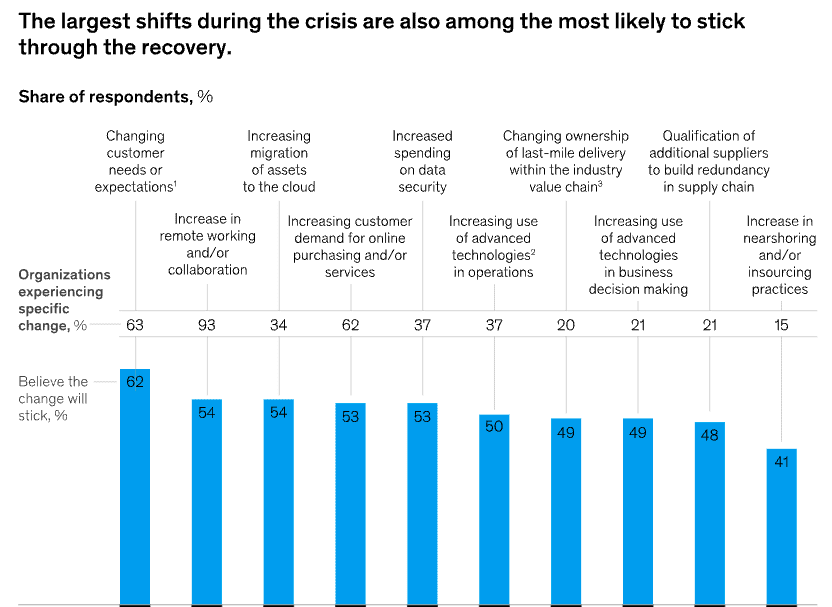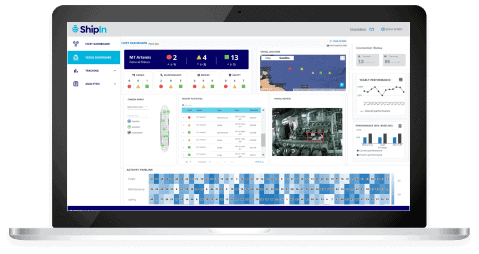The world is increasingly more digital, and there’s no turning back.
The COVID-19 pandemic accelerated the trend toward digitalization in every industry, not just in maritime. The sudden switch to remote work, staffing and logistics challenges, and changes in regulations all added up to a rapid digital transformation that everyone must adopt in order to stay competitive in the years to come.
According to McKinsey, it’s likely these changes will become permanent.

When it comes to maritime digitalization, this often refers to the rise of “smart ships” — more environmentally-friendly, efficient, and autonomous operations — using new technologies like artificial intelligence (AI) to eliminate routine or mundane tasks.
Much of this technology is already available today and beginning to be deployed on ships around the world. This increased efficiency has the potential to dramatically reshape the entire supply chain, not just on the industry or company level, adding $15 trillion to the global economy by 2030.
However, the transition to a digital maritime future isn’t always easy — there are a number of barriers to progress.
The Top 3 Barriers to Digitalization in Shipping
While the trend is clearly moving toward digitalization, change isn’t always easy.
The shipping and maritime industries have yet to catch up to the 52% of companies that accelerated their AI adoption plans in response to the pandemic. It’s not because the industry is old-fashioned, despite what nay-sayers outside the industry may think. In fact, the shipping industry remains one of the most innovative in the world.
Three main barriers currently exist to AI adoption that keep shipping companies from the immense benefits the technology has to offer, such as increased efficiency, productivity, and revenue:
1. Access to Data
Artificial intelligence runs on data, and data collection and analysis remains a huge barrier to adoption. We’ve been collecting data onboard ships for decades, which used to come in from reports, and then onboard sensors, but understanding a complete picture remains difficult. Getting data isn’t the issue. Analyzing it in a way that provides real-time decision-making opportunities is.

To be able to use AI properly, you need not just more data, but better data. This is sometimes referred to as “data hygiene,” but essentially, it’s the concept that the data you use has to be accurate, up-to-date, and as free from errors as possible — not so easy when you’re still relying on manual data entry from crew members and multiple systems. Many systems don’t “talk” to one another, or don’t provide contextual information to understand what actions to take.
2. Ship-to-Shore Communication
Ship operations today are increasingly complex. As shipbuilders construct larger and larger “mega-ships” — carrying 1500% more than they did 50 years ago — crew sizes stay the same or shrink, but have more responsibilities than ever. Work occurs 24/7 in a complex, industrial environment, operating heavy machinery, making repairs and carrying out maintenance, and preparing navigation — all while operating thousands of miles away from the onshore support system.
In order to get the most out of an investment in AI, every stakeholder needs access to the same data. It’s no good generating and accessing better data onboard if there is no collaboration in the decision-making process.
Maritime needs better ship-to-shore collaboration so that both the crew onboard and operations onshore can access the same information at the same time, and work together to make better decisions. With more visibility and transparency between the two, performance can improve, delivering more value for customers and ease of operations for team members alike.
3. Upfront Costs
Finally, any new technology comes at a cost, both in terms of the financial considerations that come with installing new hardware or software, but also in terms of human capital. The phrase “digital transformation” implies a complete overhaul of your operations in order to become more digital-first. However, adopting new technology like AI should smooth out existing processes, not completely change your entire way of doing business.
That means as you invest in technology, do so with an eye toward how you’ll use it on an everyday basis and what information and data you need to know to better manage your fleet. For example:
- Is routine maintenance taking place at the appropriate intervals?
- How long does it take for the ship to turn around in a given port?
- Which ships in the fleet operate the most efficiently, and what sets them apart from the others?
To be able to answer those questions, even with the best technology, seafarers today need training in new skills and systems such as data analysis. Otherwise, you’re making a big upfront investment without providing the foundation underneath to support it: Your crew.
Embrace Maritime Digitalization with ShipIn
At ShipIn, we make digitalization easy. Get the visibility and insights you need to improve efficiency, safety, and onboard decision-making with our patented FleetVision™ platform. Here’s how it works:
- We connect to on-camera vessels giving visibility to key areas of operation, like the cargo hold, bridge, and external access points.
- An on-vessel computer system transforms 10,000 hours of monthly footage into real-time intelligence, notifying you of security or maintenance issues, operational trends, and other patterns.
- Seafarers, fleet managers, and owners can see the same information at the same time with real-time ship-to-shore collaboration, making holistic, informed operational decisions that improve your efficiency, productivity, and scale.
Get onboard with the maritime digitalization movement today.


